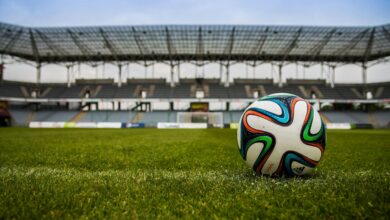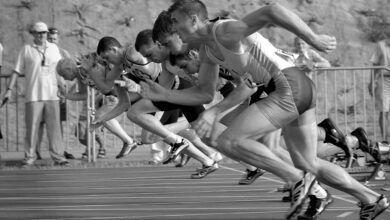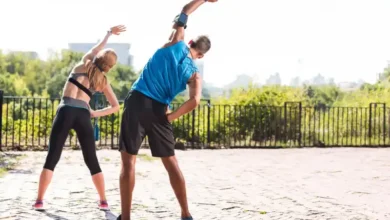Understanding The Importance Of Proper Warm-Ups And Cool-Downs In Sports

Whether you’re an elite athlete or a casual gym-goer, you’ve probably been advised to “warm up” before your workout and “cool down” afterward. While these practices are often seen as minor parts of a training routine, they play critical roles in enhancing performance, preventing injury, and aiding recovery. This article dives into the science behind proper warm-ups and cool-downs, emphasizing their significance in sports and physical activities.
What is a Warm-Up?
A warm-up is a preparatory exercise that gradually increases your heart rate, blood flow, and muscle temperature. It prepares your body for the more intense physical activity that follows. Warm-ups typically include both general and specific movements designed to target the muscles that will be used during the workout or competition.
Types of Warm-Ups
General Warm-Up
This consists of low-intensity exercises that involve the entire body, such as jogging, cycling, or skipping. The goal is to elevate your heart rate and increase circulation.
Specific Warm-Up
These exercises mimic the movements of the sport or activity you are about to perform. For example, a runner might do dynamic stretches or light sprints to prepare for a race.
Why Warming Up is Crucial
1. Increases Muscle Temperature and Flexibility
Warming up raises the temperature of your muscles, which improves their elasticity and efficiency. Warm muscles contract more forcefully and relax more quickly, enhancing speed and strength during performance. Additionally, improved flexibility can help reduce the risk of muscle strains and tears.
2. Improves Blood Circulation and Oxygen Delivery
As your heart rate increases, more blood and oxygen are delivered to working muscles. This helps them function at their best, enhancing endurance and reducing fatigue. It also primes your cardiovascular system for the demands of strenuous exercise.
3. Prepares the Nervous System
A proper warm-up prepares your nervous system by stimulating the pathways that coordinate movement. This enhances your reaction time, agility, and motor control, which are crucial in sports requiring speed, coordination, and precision.
4. Mental Preparation
Warming up prepares both your body and your mind. It allows you to focus and mentally rehearse the movements you’ll perform. This mental aspect is particularly important in competitive sports, where psychological readiness can make a significant difference in performance.
Components of an Effective Warm-Up
To ensure an effective warm-up, it’s important to incorporate a variety of exercises that target different aspects of physical preparation
1. Light Aerobic Activity
Start with 5-10 minutes of light aerobic exercises such as jogging or cycling. This boosts your heart rate and enhances blood flow.

2. Dynamic Stretching
These are controlled, smooth movements that take your muscles through their full range of motion. Examples include arm circles, leg swings, and walking lunges. Dynamic stretching is preferred over static stretching in warm-ups because it activates muscles and improves joint mobility without reducing muscle power.

3. Sport-Specific Drills
If you’re preparing for a sport, incorporate drills that mimic the movements you’ll be performing. For example, a basketball player might practice dribbling or jumping drills, while a soccer player may perform ball control exercises. For more insights into soccer preparation, including choosing the right gear, you can check out this guide on selecting soccer cleats.

Risks of Skipping the Warm Ups and Cool Downs
Skipping a warm-up can have several negative consequences. Cold muscles are more susceptible to injuries such as strains, sprains, and tears. In addition, a lack of proper warm-up can lead to suboptimal performance, as your muscles and cardiovascular system are not adequately prepared for the activity. Over time, consistently avoiding warm-ups can contribute to chronic injuries, overtraining, and burnout.
Cool-Down: The Often Overlooked Step
Just as warming up prepares your body for exercise, cooling down helps it return to its normal state afterward. A proper cool-down involves gradually reducing your heart rate and incorporating stretching exercises to help relax your muscles.
What Happens During a Cool-Down?
During intense exercise, your heart pumps large amounts of blood to your muscles to supply them with oxygen and nutrients. If you stop exercising abruptly, your heart rate drops rapidly, and blood can pool in your extremities, leading to dizziness or even fainting. Cooling down helps maintain blood flow and allows your body to return to a resting state more smoothly.
The Science Behind Cool-Downs
1. Lowers Heart Rate and Blood Pressure
Gradually reducing the intensity of your exercise allows your cardiovascular system to adjust more smoothly. Your heart rate slows down in a controlled manner, and blood pressure returns to normal levels, reducing the risk of light-headedness or fainting.
2. Reduces Lactic Acid Build-Up
Lactic acid is a byproduct of anaerobic respiration, which occurs during high-intensity exercise. Too much lactic acid can lead to muscle soreness and fatigue. A proper cool-down promotes circulation, helping to flush out lactic acid and other metabolic waste products from your muscles.
3. Enhances Flexibility and Prevents Injury
Cool-downs often include static stretching, which improves flexibility and helps prevent stiffness. Stretching while your muscles are still warm can increase your range of motion, reducing the risk of injuries in future workouts.
4. Promotes Mental Relaxation
Just as warming up prepares you mentally for exercise, cooling down provides a psychological transition from high-intensity activity to relaxation. This helps reduce post-exercise anxiety or restlessness and can improve your overall sense of well-being.
Components of an Effective Cool-Down
To properly cool down, follow these steps:
1. Light Aerobic Activity
Similar to the warm-up, start with 5-10 minutes of light cardio such as walking or jogging. This will help gradually lower your heart rate.

2. Static Stretching
Unlike dynamic stretching, static stretching involves holding a stretch for 20-30 seconds. Concentrate on the primary muscle groups engaged during your workout. For example, if you’ve been running, focus on stretching your hamstrings, calves, and quadriceps.

3. Deep Breathing and Relaxation
Incorporating deep, controlled breathing into your cool-down can help lower stress levels and promote relaxation.

The Risks of Skipping the Cool-Down
While many athletes skip the cool-down, it’s an essential part of the workout process. Failing to cool down can lead to muscle stiffness and soreness, which may impair performance in subsequent workouts. Additionally, the sudden stop of high-intensity activity can cause blood pooling, dizziness, and fainting. Over time, neglecting cool-downs can increase the risk of chronic injuries such as tendonitis and muscle strains.
Warm Ups and Cool Downs for Different Sports
Different sports and physical activities require tailored warm-up and cool-down routines. Here are a few examples:
Running
- Warm-Up: Start with light jogging followed by dynamic stretches like leg swings and walking lunges. Include some strides (short sprints) to prepare for faster running.
- Cool-Down: Gradually slow down to a walk, followed by static stretches focusing on the legs, hips, and lower back.
Weightlifting
- Warm-Up: Begin with light cardio and mobility exercises. Incorporate dynamic stretches targeting joints used in lifting, such as shoulder circles for upper body workouts or leg swings for lower body days.
- Cool-Down: Perform static stretches focusing on the muscle groups worked during the session, such as holding a quadriceps stretch after a leg day or shoulder stretches after upper body exercises.
Swimming
- Warm-Up: Start with light swimming, gradually increasing intensity. Include dynamic arm swings and shoulder rolls to loosen up the shoulders.
- Cool-Down: Swim at a slower pace for 5-10 minutes, followed by static stretches for the shoulders, back, and leg
The Role of Technology in Optimizing Warm-Ups and Cool-Downs
As sports science advances, technology has become a tool for athletes to optimize their warm-up and cool-down routines. Wearable devices, such as heart rate monitors and fitness trackers, can provide real-time feedback, helping athletes monitor their heart rate during warm-ups and ensuring they cool down properly. These tools also track workout intensity, recovery times, and overall fitness progress, enabling athletes to tailor their routines more effectively.
Summing Up – Warm Ups and Cool Downs
Warming up and cooling down are essential components of any workout or sports performance. Proper warm ups and cool downs prepare your body for the physical demands ahead, improving performance and reducing the risk of injury. Similarly, effective cool-downs promote recovery, reduce soreness, and help prevent long-term injuries. By incorporating these practices into your routine, you not only enhance your athletic performance but also safeguard your body’s longevity in sports and physical activities.





